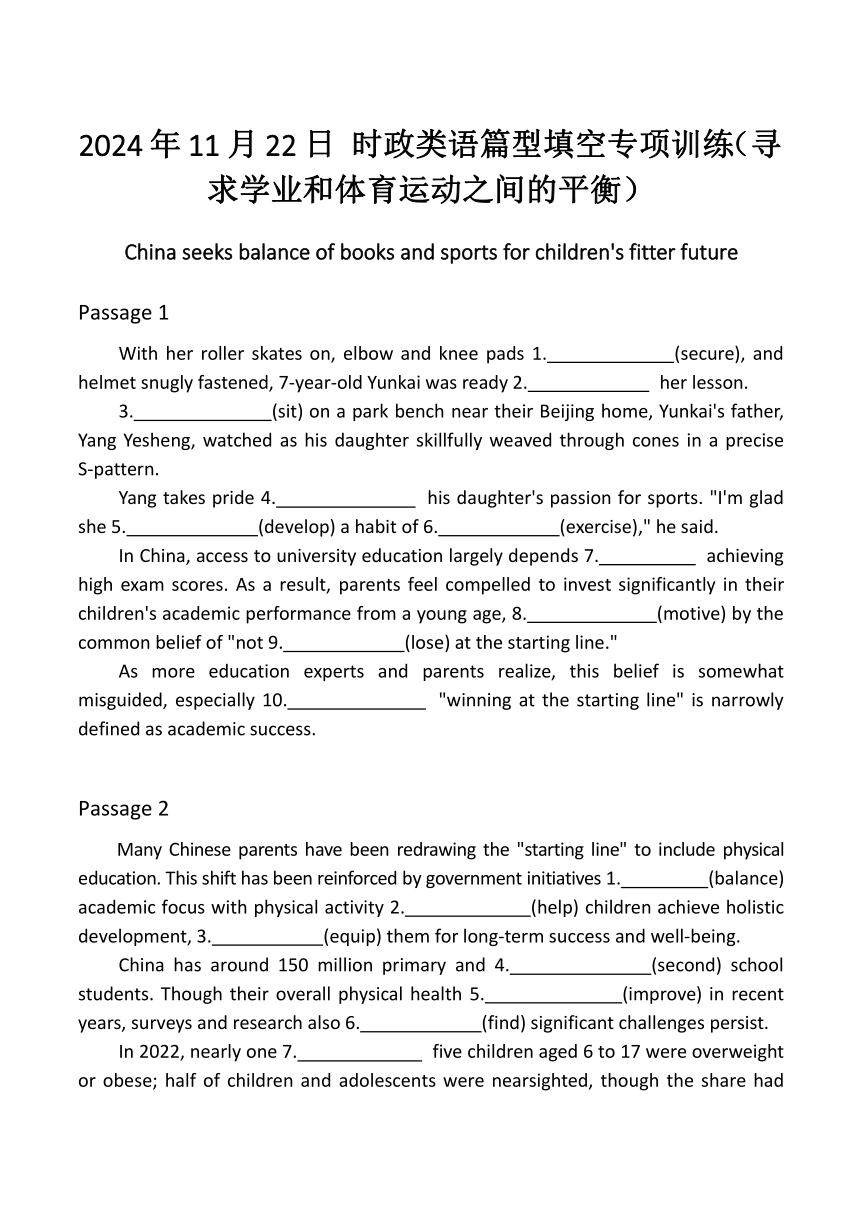
2024年11月22日 时政类语篇型填空专项训练(寻求学业和体育运动之间的平衡) China seeks balance of books and sports for children's fitter future Passage 1 With her roller skates on, elbow and knee pads 1. (secure), and helmet snugly fastened, 7-year-old Yunkai was ready 2. her lesson. 3. (sit) on a park bench near their Beijing home, Yunkai's father, Yang Yesheng, watched as his daughter skillfully weaved through cones in a precise S-pattern. Yang takes pride 4. his daughter's passion for sports. "I'm glad she 5. (develop) a habit of 6. (exercise)," he said. In China, access to university education largely depends 7. achieving high exam scores. As a result, parents feel compelled to invest significantly in their children's academic performance from a young age, 8. (motive) by the common belief of "not 9. (lose) at the starting line." As more education experts and parents realize, this belief is somewhat misguided, especially 10. "winning at the starting line" is narrowly defined as academic success. Passage 2 Many Chinese parents have been redrawing the "starting line" to include physical education. This shift has been reinforced by government initiatives 1. (balance) academic focus with physical activity 2. (help) children achieve holistic development, 3. (equip) them for long-term success and well-being. China has around 150 million primary and 4. (second) school students. Though their overall physical health 5. (improve) in recent years, surveys and research also 6. (find) significant challenges persist. In 2022, nearly one 7. five children aged 6 to 17 were overweight or obese; half of children and adolescents were nearsighted, though the share had been constantly 8. (decline). "These issues didn't arise overnight. Their causes are complex, and 9. (address) them 10. require a long-term, systematic approach," said Wu Jian, a research fellow at the China National Academy of Educational Sciences. Passage 3 1. (address) these challenges, China 2. (implement) various initiatives, including a mandate requiring two hours of daily exercise for all students -- one during school hours and one off-campus. Another, the 2021 "double reduction" policy, 3. (aim) to alleviate the burdens of homework and off-campus tutoring, freeing 4. time for sports, arts and other extracurricular activities. In particular, the government has placed greater 5. (emphasize) on physical education (PE) in schools. The 6. (revise) Law on Physical Culture and Sports, which took effect in 2023, clearly states that "schools must ensure that students take part in 7. less than one hour of physical exercise every day." Yang, 34, contrasts his daughter's experience 8. his own school days in the 1990s. "Back then, PE classes were often replaced by Chinese, math, or English, sometimes without 9. (explain)," he said. Now, at Yunkai's school, PE teachers attend parent-teacher meetings 10. (discuss) students' progress -- a dramatic shift from Yang's childhood. Passage 4 Over the past decade, sc ... ...
~~ 您好,已阅读到文档的结尾了 ~~

